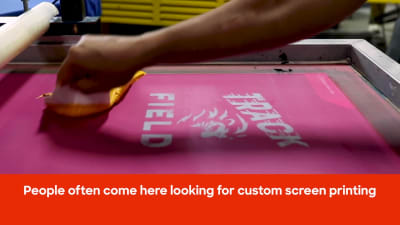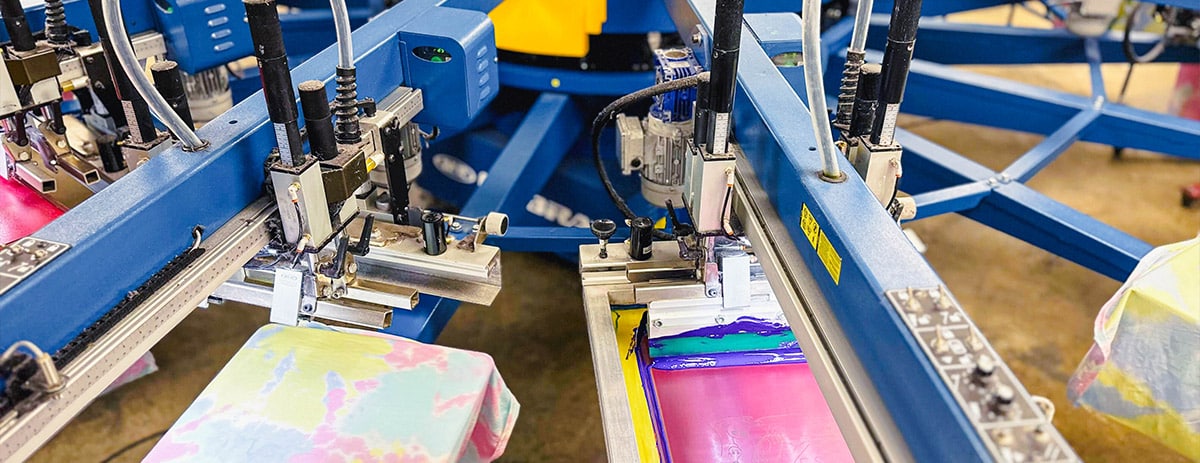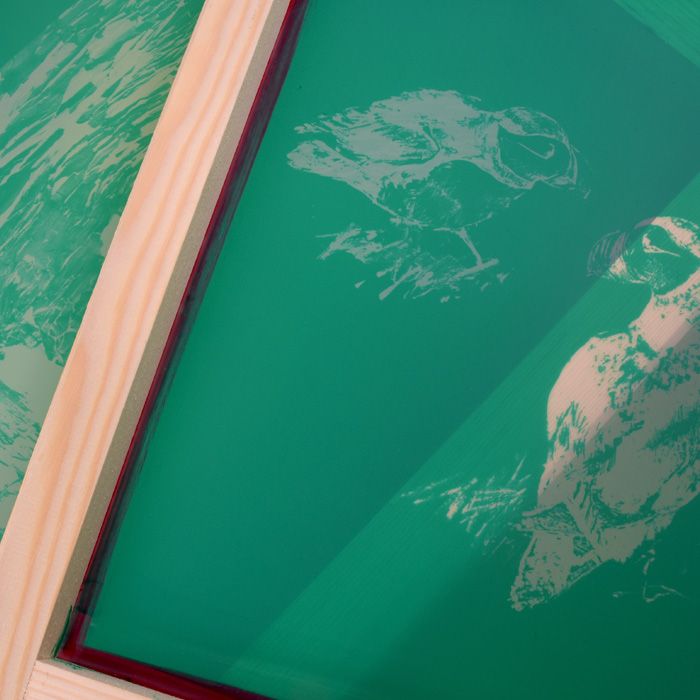Silk Screen Printing for Bold and Lasting Designs
Silk Screen Printing for Bold and Lasting Designs
Blog Article
Screen Printing Uncovered: Every Little Thing You Need to Find Out About Tee Shirt and Garment Printing Methods
Display printing is an interesting method that incorporates art with method, using countless opportunities for creativity. Prepared to check out the necessary aspects that make screen publishing an art kind?
The Fundamentals of Screen Printing: How It Works
When you dive into screen printing, you'll discover it's both an art and a science. At its core, display printing entails producing a stencil, or screen, that enables ink to pass through just in specific locations.
Following, you'll blend your inks and prepare your printing surface area. Placement the screen over the fabric, after that make use of a squeegee to push ink with the screen onto the garment. This process requires accuracy, as you desire clear, vivid prints. After printing, you'll cure the ink with warm, guaranteeing it complies with the material and lasts with cleans. Each step is crucial, and grasping them will elevate your display printing skills, transforming straightforward garments right into special, meaningful pieces.
Kinds Of Display Printing Strategies
As soon as you grasp the basics of screen printing, it's time to discover the numerous techniques that can boost your designs. One preferred method is traditional display printing, where ink is pressed with a stenciled screen.
If you're going for great details, consider discharge printing. This method removes color from the material, leaving a soft, classic appearance. Another choice is plastisol printing, understood for its longevity and vibrant colors, making it a favored for numerous brands. Experiment with halftone printing to create slope impacts and complex layouts. Each method has its unique beauty, so do not be reluctant to try them out to discover what fits your design best!
Necessary Devices for Screen Printing
To attain sensational cause display printing, having the ideal equipment is essential. You'll need a sturdy screen printing structure, which holds the mesh that moves your layout onto the garment. Next, spend in top quality mops; these are important for using ink evenly across the screen. You'll also require an excellent direct exposure unit to produce your displays, as well as a washout booth for cleaning them after use. A dependable warm resource, like a conveyor dryer or heat press, is crucial for treating your prints to guarantee longevity. Do not forget an appropriate work area, geared up with tables and storage for your materials. Protective equipment, such as gloves and masks, will certainly keep you secure from chemicals and inks. With the right tools, you'll be well on your way to generating professional-quality prints.
Choosing the Right Inks and Products
When choosing inks and products for display printing, you need to take into account the kind of ink that functions best for your project. Think of textile compatibility to assure your styles look fantastic and last long. Likewise, explore environmentally friendly ink options to make your printing procedure more lasting.
Kinds of Screen Inks
Selecting the appropriate screen ink is important for attaining vibrant, long lasting prints that fulfill your job's requirements. There are several types of display inks to analyze. Specialized inks, such as metallic or glow-in-the-dark, can include distinct effects to your layouts.

Fabric Compatibility Considerations
Comprehending fabric compatibility is important for attaining premium screen prints, particularly given that various products react distinctively to numerous inks. Always check your inks on sample fabric to ensure they adhere appropriately and keep color stability. Furthermore, maintain in mind that fabric weight and texture can affect the last result, so choosing the right ink and material combo is important for your job's success.
Eco-Friendly Ink Options
Environmentally friendly inks are coming to be a preferred selection for display printers that want to decrease their ecological influence while keeping high quality. When selecting inks, consider water-based inks, which are much less dangerous and much easier to cleanse up compared to typical solvents.
Furthermore, search for inks made from renewable sources, such as soy or vegetable-based alternatives. By selecting the appropriate inks and materials, you'll not just develop magnificent layouts however also contribute to a more lasting printing procedure. Make the button, and your prints will mirror your dedication to the setting!
Preparing Your Layout for Display Printing

Submit Format Demands
To guarantee your layout looks vibrant and sharp on fabric, you'll need to pay very close attention to file layout demands for screen printing. Begin with vector documents like AI or EPS, as they can be scaled without losing high quality. If you utilize raster images, go with high-resolution files, such as TIFF or PNG, preferably at 300 DPI. Avoid utilizing JPEGs, as they can shed quality when resized. Make certain your layout has a transparent history to prevent undesirable white sides on your prints. Maintain color modes in mind; CMYK is conventional for display printing, so transform your RGB makes as necessary - screen printing kit. By following these guidelines, you'll set your artwork up for a successful print.
Shade Splitting Up Techniques
Shade separation is a crucial action in preparing your design for display printing, and understanding it can greatly improve your print quality. You'll require to break your style into specific colors, as each shade requires a different screen throughout printing. This precision not only ensures precise color depiction however additionally enhances the printing procedure.
Resolution and Size
Attaining the most effective cause display printing starts with assuring your design has the right resolution and dimension. Ideally, your art work needs to be at the very least 300 DPI (dots per inch) for sharp, clear prints. If you make use of lower resolution, your end product might look unprofessional and pixelated.
When it concerns dimension, think about the measurements of your print area. Style your art work to match the final print dimension, preferably creating it in the real measurements you'll be printing. In this manner, you'll avoid any kind of unforeseen scaling issues.
Always examine your layout in both vector and raster layouts. Vector graphics can be scaled without losing quality, making them perfect for display printing. Preparing correctly will assure your design looks remarkable on every garment!
Step-by-Step Screen Printing Process
Screen printing is a dynamic procedure that enables you to create lively layouts on numerous surface areas. To get started, you'll need a display, emulsion, and your picked ink. Prepare your screen by cleansing it completely. Next, apply the solution equally and let it completely dry in a dark location. As soon as dry, expose your screen to light with your style positioned on it, which will harden the emulsion where the light hits, creating a stencil - screen printing kit.
After washing out the unexposed solution, your display is all set. Establish it up on your printing surface area and straighten your garment under it. Pour ink onto the screen and use a squeegee to press the ink via the pattern onto the material. Lift the screen thoroughly and let the print completely dry. Ultimately, heal the ink utilizing heat to guarantee longevity. That's it! You've efficiently screen printed your design.
Tips for Effective Display Printing Projects
While you're diving into your screen printing jobs, click over here now bear in mind that preparation is crucial to success. Beginning by gathering all your materials-- inks, mops, screens, and garments. A tidy office aids stop unwanted mistakes, so clean up prior to you start.
Next, confirm your artwork is high-resolution and appropriately sized for your garment. Examine your screen for correct direct exposure and tidy it thoroughly to prevent spots. When mixing your inks, adhere to the manufacturer's standards to attain the best uniformity.
Throughout printing, apply even stress with your squeegee for consistent outcomes. Do not hurry; take your time to confirm each print fulfills your standards. After printing, allow your garments completely dry totally prior to dealing with or packaging them.
Lastly, constantly maintain a sample of your job for future reference. In this manner, you can assess your progression and boost your methods in time. Satisfied printing!

Regularly Asked Inquiries
How much time Does It Require To Establish a Display Printing Work?
Setting up a screen printing job normally takes around half an hour to an hour. You'll prepare the screens, mix inks, and readjust the press. The time varies based on complexity and experience, so stay organized!
Can I Print on Different Material Enters Utilizing the Exact Same Strategy?
Yes, you can publish on various fabric types utilizing the exact same technique, but you'll need to readjust your setups and inks. Some textiles take in discover this ink in a different way, so trying out warranties the best results for each material.
What Prevail Blunders to Avoid in Screen Printing?
When screen printing, stay clear of usual errors like utilizing the wrong ink, overlooking proper exposure times, or missing pre-press checks. Always test your configuration and maintain tidy screens to ensure quality outcomes each time.
Exactly How Can I Correctly Tidy and Maintain My Display Printing Equipment?
To effectively tidy and maintain your display printing tools, you must on a regular basis wash displays with suitable solvents, examine mops for wear, and assure all devices are saved dust-free and dry. Uniformity prevents expensive repair services and enhances efficiency.
Is Display Printing Eco-friendly Compared to Various Other Techniques?
Screen printing can be much more ecologically pleasant than various other methods, particularly if you make use of eco-conscious products and water-based inks. By picking sustainable materials and practices, you minimize waste and decrease your effect on the world.
Display Printing Uncovered: Everything You Need to Know Regarding T-Shirt and Garment Printing Strategies
At its core, screen printing includes creating a stencil, or display, that permits ink to pass via just in specific locations. Position the display over the textile, then use a squeegee to press ink with the display onto the garment. One prominent approach is standard display printing, where ink is pushed through a stenciled screen.When selecting inks and materials for screen printing, you need to take into account the type of ink that works ideal for your task.
Report this page